| Publications: SRL: EduQuakes |

EduQuakes
March/April 2008
MASE: Undergraduate Research and Outreach as Part of a Large Project
Xyoli Pérez-Campos
Universidad Nacional Autónoma de México
INTRODUCTION
The MesoAmerican Subduction Experiment (MASE) is a collaboration between the Tectonics Observatory at the California Institute of Technology (Caltech), the Universidad Nacional Autónoma de México (UNAM), and the Center for Embedded Networked Sensing (CENS) at the University of California in Los Angeles (UCLA). Its main objective is to model and understand the dynamics of the subduction of the Cocos plate under the North American plate. In the first stage of the project, 100 broadband seismometers were deployed along a line that crosses Mexico from Acapulco on the Pacific coast to Tempoal, close to the Gulf of Mexico (figure 1) (Pérez-Campos, Clayton et al. 2006; Clayton et al. 2007). This line goes through six Mexican states, with the stations distributed among 84 different towns, including seven cities (Acapulco, Chilpancingo, Iguala, Cuernavaca, Mexico City, Pachuca, and Huejutla). Security was an important factor when selecting sites, and schools turned out to be nearly ideal in this respect. In total, 53 MASE stations are situated in schools that range from K–12 through university level, and another six were housed within cultural or educational centers. This situation presented an excellent opportunity to provide educational out-reach, particularly to rural communities. Usually, the schools in small towns draw students from neighboring communities, which means that outreach impact is spread beyond the specific MASE sites.
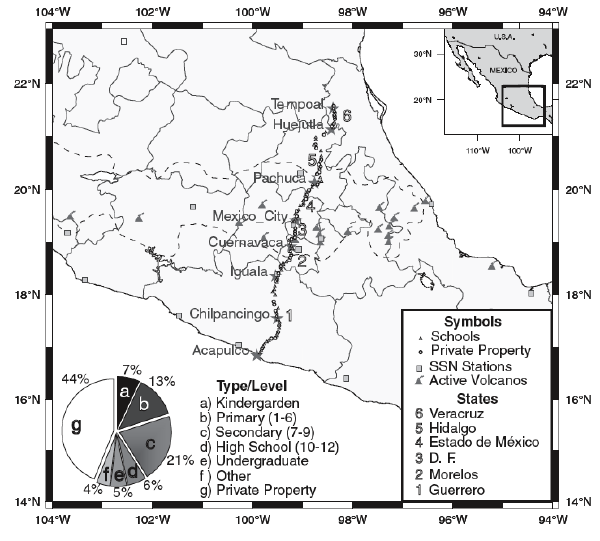
▲ Figure 1. Station location and type. The symbol of each station represents the type of site (school/private property). Six states hosted MASE stations, indicated by outlined numbers. Major cities and key towns are indicated by a star. The lower pie chart indicates the per-centage of each school level or type of site along the MASE line.
MASE OUTREACH PROGRAM
Mexico is a country where large earthquakes have caused sub-stantial destruction and death. People generally remember the 1985 Michoacán earthquake due to the devastation it produced in Mexico City, but other, smaller earthquakes have caused sig-nificant damage in small towns close to their epicenters. It is therefore crucial to educate people in understanding a phenom-enon that affects their daily lives and to prepare them to deal with it.Undergraduate students in Mexico are required to partici-pate in a social service program (SSP) in order to graduate. Its objective is to have students apply what they have learned in their bachelor’s studies to benefit Mexican society. This not only consolidates the students’ academic and professional training, but it also promotes their societal awareness and helps spread the benefits of science, technology, and culture (UNAM 1985). MASE SSP is part of this program and involved undergraduate students from UNAM’s School of Engineering.
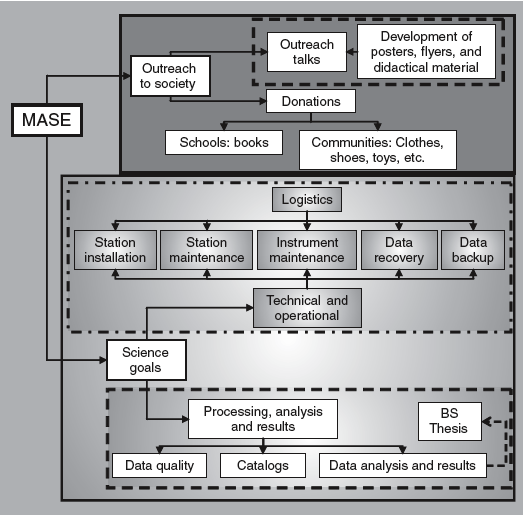
▲ Figure 2. MASE social service program (SSP). Upper panel shows outreach activities and lower panel shows those related to research. Dashed lines include activities that favor student’s knowledge in seismology. Dash-dotted lines include activities that promote logistics, operational, and technical skills. Notice that those students involved in data and results analysis have the option of writing a bachelor’s thesis.
The main goal of the MASE project was to obtain a good image of the subduction of the Cocos plate underneath the North American plate, but such a large project entails com-mitment toward the communities that are voluntarily hosting a seismic station. Through the MASE SSP we are able to bring information about basic seismology, the Earth’s interior, earth-quakes in Mexico, seismic risk and preparedness, and MASE itself to the MASE communities.
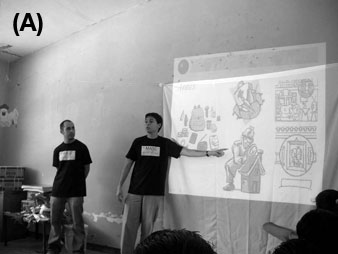
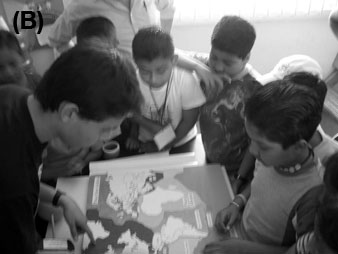
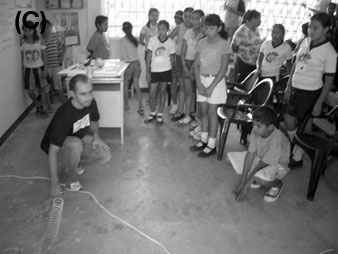
▲ Figure 3. Outreach talks. (A) Undergraduate student talking about seismic preparedness. (B) Elementary school students playing with a plate tectonics puzzle. (C) Demonstration of body wave polarization to sixth graders.
The MASE SSP has two components: research and out-reach (figure 2). Both components have benefited from the participation of undergraduate students, who in turn success-fully fulfill their SSP requirements. Undergraduate students have been involved since the beginning of MASE in opera-tional activities such as installing stations, maintaining stations and instruments, collecting and backing up data, and collecting equipment at the end of the experiment. These activities have improved their logistical, organizational, and technical skills. They have also actively participated in analyzing data, includ-ing data-quality analysis, catalog generation, and receiver function analysis (Pérez-Campos 2006). Some of these studies have been presented in meetings (e.g., Greene-Gondi et al. 2007; Real-Pérez and Pérez-Campos, 2007) and have often become bachelor’s theses (e.g., Espejo Arellano and Greene Gondi, 2007). These activities have awakened the students’ interest in seismology and science in general and developed their research skills. Such students have been the driving force of the MASE outreach program (Pérez-Campos et al. 2005; Pérez-Campos, Rodríguez et al. 2006).
The outreach component has two aspects: outreach talks and donations. For MASE sites that are in educational centers, we conduct outreach talks and book donations, while for sites on private property in small rural communities, we organize donations of clothes, shoes, toys, etc. (figure 3). The outreach program includes the distribution of posters, fliers, and other educational material such as plate tectonics puzzles, seismology memory cards, and models of the Earth’s interior. This program has helped students to better understand outreach communi-ties and enhanced their commitment to society.
Since the schools ranged from K–12 to university level, outreach presentations had to be flexible to adapt to the audience; therefore, they were designed as PowerPoint presentations with self-explanatory images and very little text so the ideas could be explained in a simple manner to small children and in a deeper and more technical manner to university students.
As part of MASE, we have generated a collection of edu-cational material in Spanish. The fliers include information from civil authorities in the six states where MASE has seis-mic stations. When the MASE stations were removed from each site at the end of the deployment, we handed out a poster that explained what the station was able to measure. Its title, in English, is “How is the Earth under my school?” (figure 4; Castro-Arteola and Pérez-Campos 2007). This poster presents MASE and its objectives in a simple way and shows the seis-mometer installed in the schools along with an example record. It discusses the seismic waves traveling inside the Earth and presents a profile of receiver functions along the MASE line.
RESULTS
The MASE SSP has been beneficial for science and outreach. MASE science would never have been accomplished if it were not possible to deploy stations at schools. Most of the schools were small rural schools that contributed very little to noise levels. For the largest schools there is a difference up to 5 dB above 1 Hz during school hours, but this also can be attributed to other cultural activity, such as traffic (Real-Pérez and Pérez-Campos 2007). The schools themselves provide an ideal mecha-nism for undergraduate students at UNAM to provide outreach to the community. The UNAM students have acquired experi-ence and skills in various and very broad aspects. Furthermore, they have developed societal responsibility and commitment as a result of being in close contact with people and children living and studying in harsh conditions. For example, some schools have only one classroom, without glass windows, and in some cases students have to walk more than an hour to get there. One MASE station was located in a small community that consists of 15 shacks with dirt floors. To date, seven students have con-cluded their SSPs, and five more have volunteered part-time in different activities as part of MASE.
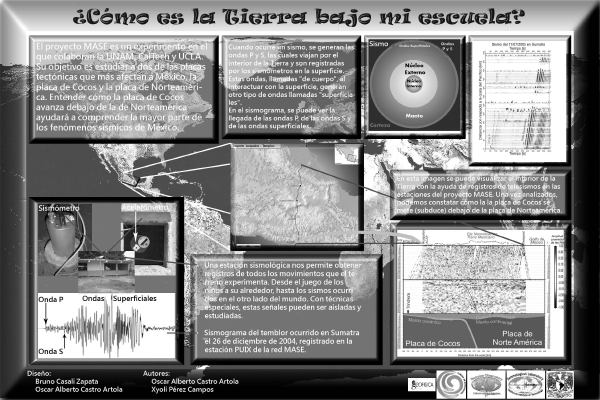
▲ Figure 4. “How is the Earth under my school?” Poster in Spanish where outreach merges with MASE research objectives. It states the MASE objectives (top left), shows a seismic station and the record of the 2004 Sumatra earthquake at one MASE station (bottom left and center), explains the propagation of seismic waves inside the Earth (top center and right), and presents MASE receiver functions results (bottom right) (Castro-Arteola and Pérez-Campos 2007). Click to see a larger version of this image.
Many people, mainly youngsters, have benefited from a MASE outreach talk, and they in turn can be a link to their communities and disseminate the knowledge to their families, friends, and neighbors. We estimate that at least 2,700 students from all levels have listened to a MASE outreach talk. At some schools parents have attended, which increases this number by another 300 people (figure 5A). At some schools after a MASE outreach talk we have noticed signs colored by the students themselves that describe what to do in case of an earthquake (figure 5B). In addition, through MASE SSP people have donated clothes, shoes, and toys to small communities that have gratefully received them.
CONCLUSIONS
Projects such as MASE that require the deployment of valuable equipment at distributed sites for an extended period of time can benefit by utilizing the infrastructure of schools. There is a two-way partnership in which the project, in exchange for a secure site, will conduct outreach in the schools through talks and book donations. In particular, in the case of the MASE SSP, this outreach was coupled with a program at UNAM, which enabled a significant number of undergraduates to participate and get credit for their efforts. ![]()
ACKNOWLEDGMENTS
MASE would like to thank all those communities that have hosted a MASE station and all the students who have partici-pated in the MASE SSP and volunteered for MASE activities. This program has been possible thanks to the support of Arturo Iglesias and Jorge Soto Peredo from the Instituto de Geofísica, UNAM; Carlos M. Valdés-González, head of the Servicio Sismológico Nacional; Robert W. Clayton at Caltech; and Martín Cárdenas Soto, head of the Department of Geophysical Engineering at the School of Engineering, UNAM. All of them are committed to outreach to society. The author appreciates R. Mellors’s comments, which improved this manuscript. This program has been financed by the Tectonics Observatory at Caltech and the DGAPA-UNAM project PAPIIT IN119505-3.
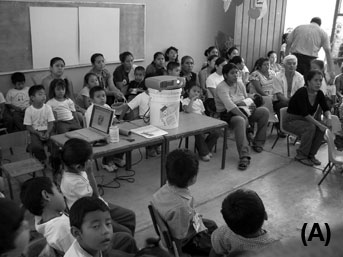
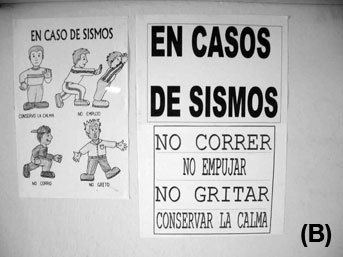
▲ Figure 5. Outreach program results. A) Kindergarten students along with their parents and teachers listening to a MASE outreach talk. B) Signs colored by elementary school students after a MASE outreach talk.
REFERENCES
Castro-Arteola, O., and X. Pérez-Campos (2007). “The Earth under my shoes,” a poster where outreach and research merge. EOS, Transactions, American Geophysical Union 88 (23), Jt. Assem. Suppl. Abstract ED41C-04.
Clayton, R., P. M. Davis, and X. Pérez-Campos (2007). Seismic struc-ture of the subducted Cocos plate. EOS, Transactions, American Geophysical Union 88 (23), Jt. Assem. Suppl. Abstract T32A-01.
Espejo Arellano, L., and F. Greene Gondi (2007). Geometría de la subduc-ción de Acapulco, Gro. a Puente de Ixtla, Mor. a partir de funciones receptor. Bachelor’s thesis, Facultad de Ingeniería, Universidad Nacional Autónoma de México, 113 pps.
Greene-Gondi, F., L. Espejo-Arellano, X. Pérez-Campos, Y. Kim, and R. W. Clayton (2007). Geometry of Cocos plate beneath Guerrero using receiver functions. EOS, Transactions, American Geophysical Union 88 (23), Jt. Assem. Suppl. Abstract S43B-02.
Pérez-Campos, X. (2006). Un proyecto en Sismología: Compromiso con la sociedad, conocimiento y experiencia. Coloquio “Compromiso y Responsabilidad Social, 70 Aniversario del Servicio Social en la UNAM,” UNAM.
Pérez-Campos, X., R. W. Clayton, F. Greene, L. Espejo, and A. Iglesias (2006). A receiver function image on how Cocos subducts beneath North America. UGM Reunión Anual 2006. GEOS, Unión Geofísica Mexicana 26 (1), 179.
Pérez-Campos, X., L. E. Rodríguez, L. Espejo, F. Greene, A. Iglesias, R. W. Clayton, T. A. Reyes, and E. A. Solano (2006). MASE: A great opportunity for outreach to the rural communities in Mexico. EOS, Transactions, American Geophysical Union 87 (52), fall meeting sup-plement, abstract T11B-0438.
Pérez-Campos, X., L. A. Rodríguez Abreu, L. Espejo Arellano, F. Greene Gondi, T. A. Reyes Pimentel, E. A. Solano Hernández, J. Soto Peredo, A. Iglesias, and R. W. Clayton (2005). Aprovechando el proyecto MASE para divulgar la Sismología en México. UGM Reunión Anual 2005. GEOS, Unión Geofísica Mexicana 25 (1), 189.
Real-Pérez, J. A., and X. Pérez-Campos (2007). Evaluation of noise and site effects at MASE stations. EOS, Transactions, American Geophysical Union 88, (23), Jt. Assem. Suppl. Abstract S43B-05.
UNAM (1985). Reglamento general de servicio social de la Universidad Nacional Autónoma de México. Gaceta UNAM, 8ª Epoca, 1 (46).Departamento de SismologíaInstituto de GeofísicaUniversidad Nacional Autónoma de Méxicoxyolipc@gmail.com
Departamento de Sismología
Instituto de Geofísica
Universidad Nacional Autónoma de México
xyolipc@gmail.com
[Back]
Posted: 14 March 2008
